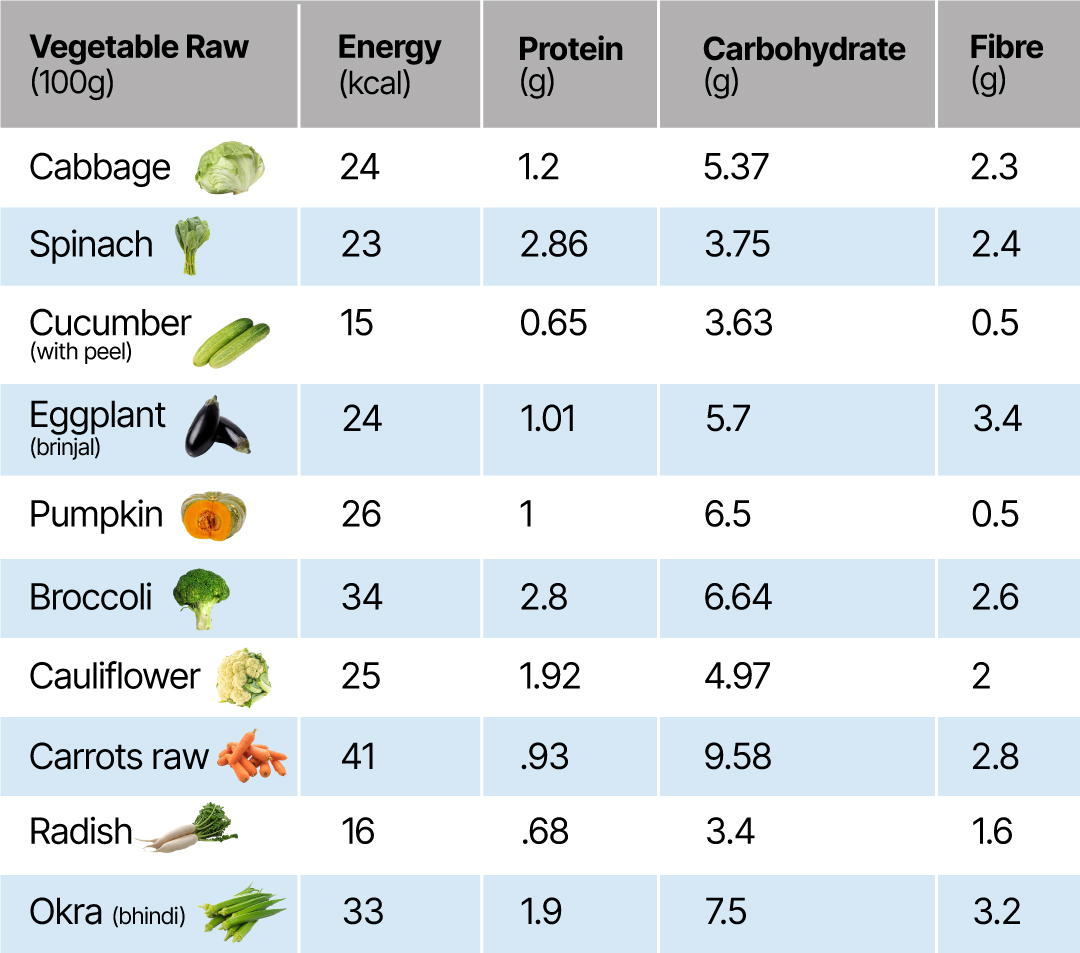Why having leafy vegetables at the beginning of a meal can control your blood sugar better?
They are rich in fibre, which prevents sugar spikes. WHO suggests consuming more than 400 grams of vegetables per day to improve overall health and reduce the risk of non-communicable diseases. Contrary to popular perception, the vegetable consumption in India is way below recommended standards, averaging only 150 gm/day
 Aim to fill about half of plate at each meal with non-starchy vegetables like spinach, cucumber, eggplant , radish and broccoli (Source: Getty Images/Thinkstock)
Aim to fill about half of plate at each meal with non-starchy vegetables like spinach, cucumber, eggplant , radish and broccoli (Source: Getty Images/Thinkstock) How often have you felt bored with your doctor’s advice, “Please increase your vegetable intake?” A standard recommendation given by doctors and nutritionists to all people with diabetes is to consume a lot of vegetables, particularly the leafy ones. In fact, we always suggest replacing refined carbohydrates in the diet with vegetables, which are the edible parts of a plant, such as the leaves, stem, roots and bulbs. Fruits come from the flowering part of a plant and contain seeds. Typically, fruits are sweet while vegetables have a somewhat salty, spicy taste. Studies suggest that eating vegetables before other foods in the meal may help lower post-meal blood sugars. It may, therefore, be a good idea to start your meal with leafy vegetables.
Why is this sequencing important and why should we increase vegetables in a diet for diabetes? Are all vegetables the same, or are some better than others? Does the method of cooking make any difference? In this column I will answer some of these often-asked questions.
Leafy vegetables provide soluble and insoluble fibre, antioxidants, vitamins and minerals. Moreover, they contain a variety of beneficial substances, including plant sterols, flavonoids and other antioxidants, which have anti-inflammatory properties. WHO suggests consuming more than 400 grams of vegetables per day to improve overall health and reduce the risk of non-communicable diseases. Contrary to popular perception, the vegetable consumption in India is way below recommended standards, averaging only 150 gm/day.
Vegetables play an even more important role in people with Type 2 diabetes. Carbohydrate content, portion size and the glycaemic index (how quickly a food raises blood glucose) determine post-meal glucose surge. The high fibre content in vegetables blunts post-meal spikes, provides greater satiety despite being lower in calories than cereals, and lends variety and flavour. No single vegetable has all the desirable properties, so eating a variety of vegetables is important!
Good choices of vegetables for people with Type 2 diabetes are those that are rich in fibre and contain a variety of vitamins, minerals and antioxidants. Some antioxidants may have specific benefits for people with Type 2 diabetes. These include alpha-lipoic acid (ALA), found in green leafy vegetables, such as kale and spinach, N-acetylcysteine (NAC), present in allium vegetables, such as onion and garlic, and Vitamin C, abundant in citrus fruits, red and green peppers, strawberries, and broccoli. Vegetables that contain nitrates, which reduce blood pressure are also a good choice (e.g. rocket leaves, beetroot, lettuce, celery, and radish).
Proteins in vegetables
Plant sources of protein include tofu, chickpeas and peanuts. Although vegetables are not a great source of protein, some are more protein-rich than others. Vegetables like watercress or jalkumbhi, alfalfa sprouts, spinach, asparagus, mustard greens or sarson saag, collard greens or haak saag, broccoli, Brussels sprouts and cauliflower, all contain between 2 and 4 gm of protein per 100 gm.
 The portion size of starchy vegetables one can eat depends on the dietary needs and carbohydrate goals per meal (Designed by Abhishek Mitra)
The portion size of starchy vegetables one can eat depends on the dietary needs and carbohydrate goals per meal (Designed by Abhishek Mitra)
Gut health and vegetables
The gut microbiome plays a significant role in the metabolism of carbohydrates and fats and can influence the body’s ability to regulate blood sugar levels. Studies have found that individuals with type 2 diabetes have a less diverse and less balanced gut microbiome compared to healthy individuals. The fibre from leafy vegetables we eat provides food for the bacteria in our gut. These fibres are indigestible by humans but are broken down easily by our friendly gut bacteria and help them to reproduce, thus balancing our microbiome. The best vegetables for a heathy gut are spinach, okra, garlic, onion, mushrooms, bok choy, arugula, cabbage, and cauliflower.
The rainbow plate
Aim to fill about half of plate at each meal with non-starchy vegetables like spinach, cucumber, eggplant , radish and broccoli. Starchy vegetables, like peas, corns, potatoes (including the sweet variety) contain vitamins, minerals, nutrients and fibre, though they’re also higher in carbs than the non-starchy vegetables. In general raw vegetables have more fibre than cooked or processed vegetables. If you deep fry vegetables or make them part of a rich curry, you are losing their beneficial properties. Your plate should always have a quarter of roti/chawal and at least half part vegetables.
The portion size of starchy vegetables one can eat depends on the dietary needs and carbohydrate goals per meal. A cup of starchy vegetables has about 30 grams of carbohydrates, or two carbohydrate servings. One of the most frequently asked questions pertains to potatoes. Many feel that potatoes are prohibited in diabetes. It is acceptable to eat potatoes as a part of a balanced meal but you need to count them in your daily carbohydrate intake and remember to not deep fry! Eating potatoes with food rich in fibre, lean protein and healthy fats is preferable as it can lower the glycaemic index of the meal.
- 01
- 02
- 03
- 04
- 05































